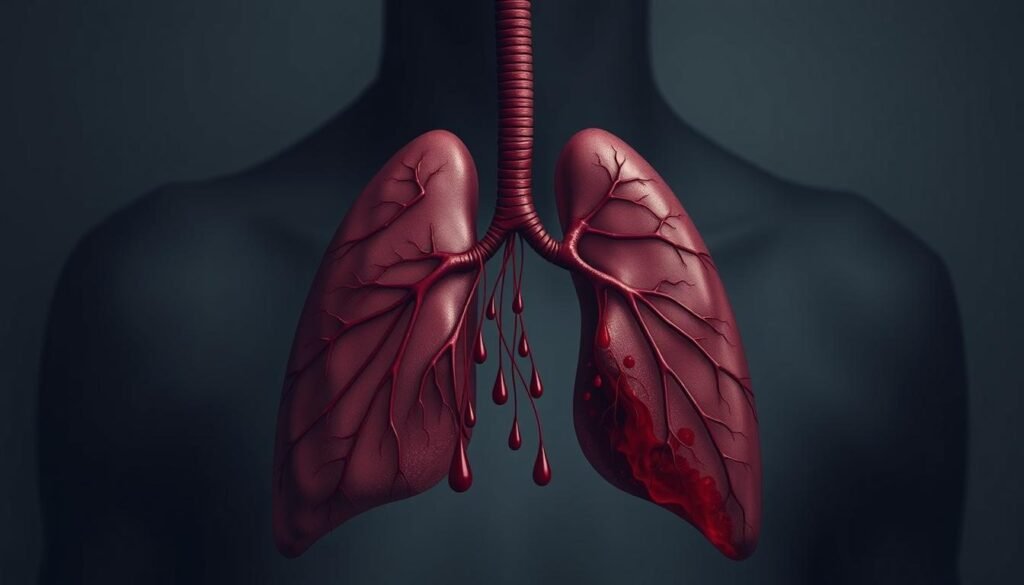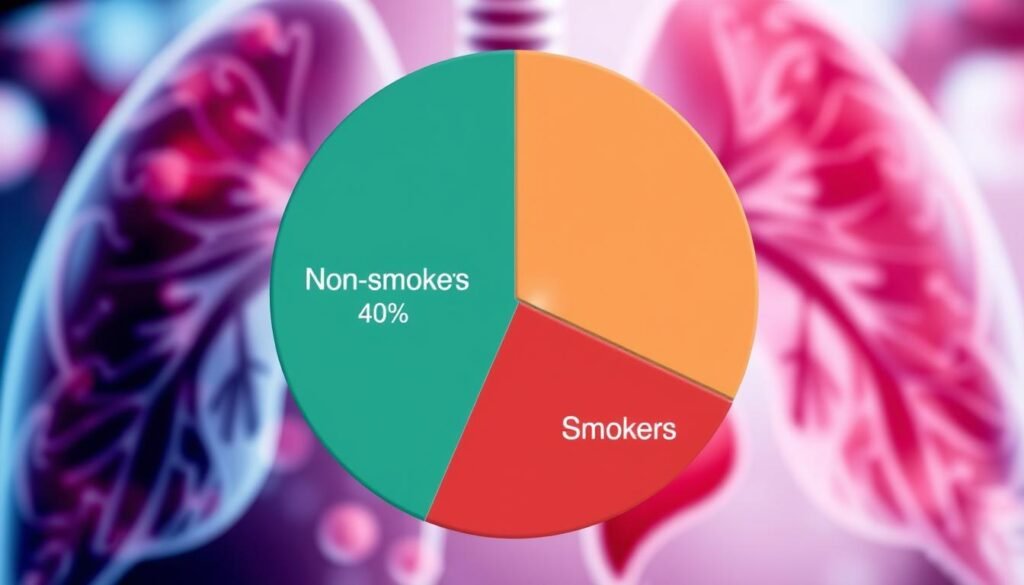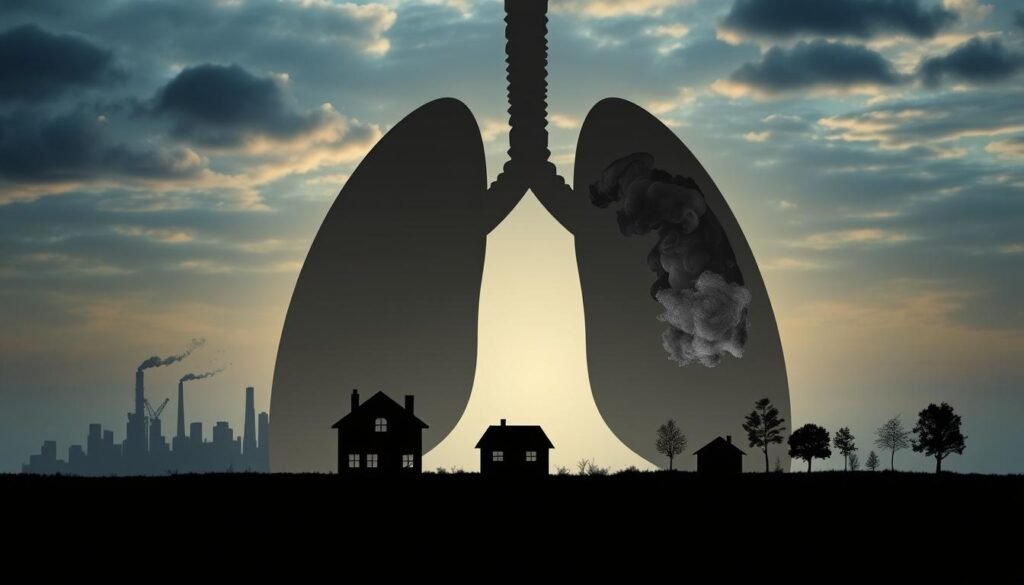Did you know about 43,000 people in the UK are diagnosed with lung cancer each year? This high number shows how common lung cancer is. It can have surprising symptoms like nosebleeds. While often not serious, nosebleeds in lung cancer patients could point to bigger health issues.
This article explains the link between lung cancer and nosebleeds. We’ll cover common causes of nosebleeds, key lung cancer facts, and why these might be connected. Knowing these connections helps people look out for their health better. They can seek advice early when dealing with these complex problems.
Key Takeaways
- Nosebleeds can indicate underlying health issues, particularly in patients with lung cancer.
- Approximately 43,000 annual lung cancer diagnoses in the UK emphasize the disease’s prevalence.
- Non-small cell lung cancer makes up 88% of lung cancer cases.
- Early diagnosis is crucial, as survival rates dramatically decline in later stages of lung cancer.
- Awareness of nosebleeds can help in recognizing potentially serious health concerns.
- Relationship between lung cancer treatments and increased incidence of nosebleeds is important for patients.
- Regular medical check-ups and screenings for at-risk individuals are vital.
Understanding Nosebleeds: What Causes Them?
Nosebleeds, or epistaxis, happen to many people at least once. In the U.S., one in seven folks will have a nosebleed. Knowing why they occur is key to handling them well.
Common Triggers for Nosebleeds
Many things can cause a nosebleed. Some common triggers for nosebleeds are:
- Minor injuries from nose picking
- Face or nose trauma
- Dry air from heating or cold weather
- Foreign objects in the nose, especially in kids
- Blood-thinning meds, like warfarin or aspirin
- Health issues like high blood pressure or HHT
Dry air can make your nose’s inside crack and bleed. If nosebleeds happen a lot, it might be time to see a doctor.
When to Seek Medical Attention
It’s important to know when to seek medical attention for a nosebleed. You should get emergency care if:
- The nosebleed goes on for more than 20 minutes
- There’s a lot of blood loss or trouble breathing
- You feel dizzy or confused
See a doctor if you get nosebleeds often or have a bleeding disorder. This is especially true for older folks or those with high blood pressure.
Understanding the causes of nosebleeds and acting fast helps you take care of your health.
Lung Cancer Overview: Key Facts
Lung cancer is a major health issue worldwide. It takes more lives each year than breast, colon, and prostate cancers combined. By learning about lung cancer, we can push for early detection.
Statistics on Lung Cancer Rates
In the US, lung cancer mainly affects older adults. It’s rare in people under 45. Non-small cell lung cancer (NSCLC) represents most cases.
About 20% of cases are small cell lung cancer (SCLC). While smoking causes most lung cancers, non-smokers can get it too. Air pollution, arsenic in water, and exposure to harmful materials also increase risk.
Common Symptoms of Lung Cancer
Early symptom recognition can catch lung cancer sooner. Look out for:
- Persistent cough
- Chest pain
- Fatigue
- Unexpected weight loss
- Loss of appetite
- Shortness of breath
Doctors might use CT scans, x-rays, or biopsies to diagnose it. Catching it early is key for better treatment results.
Sometimes, lung cancer spreads to places like the nasal cavity. It shows why full check-ups are critical. For more on lung cancer reaching the nasal cavity, read the study here.
The Connection between Lung Cancer and Nosebleeds
Lung cancer and nosebleeds are closely linked, especially because of how cancer treatments work. Chemotherapy and other therapies often lower platelet count. Platelets are crucial for blood clotting. With fewer platelets, people can have more and worse nosebleeds. This is called epistaxis. It’s important to understand this to manage and treat these symptoms well.
How Cancer Treatments Affect Nosebleeds
Treatments like chemotherapy are common for lung cancer. They can make it hard for the body to keep platelets at a healthy level. This makes nosebleeds more likely. When platelet levels are low, blood vessels in the nose can break easily. This leads to bleeding. Studies show that the risk of cancer in people with nosebleeds was 0.59% in 90 days.
Role of Platelet Count in Nosebleeds
Platelet count plays a big role in nosebleeds, especially for cancer patients. Cancer treatments often lower platelet count. This increases the chance of getting nosebleeds often. As treatment goes on, nosebleeds might happen more due to various reasons. This includes the treatments or other health issues. Studies have found a link between blood cancers and nosebleeds. The risk is higher in patients with a history of epistaxis.

| Condition | Standardized Incidence Ratio (SIR) | 95% Confidence Interval (CI) |
|---|---|---|
| Epistaxis | 1.85 | 1.69 – 2.02 |
| Haemoptysis | 14.6 | 13.5 – 15.7 |
| Haematological Cancers | 5.78 | 4.62 – 7.14 |
What Percentage of Non-Smokers Get Lung Cancer?
Lung cancer is not just a smoker’s disease. About 20% of those who get lung cancer have never smoked. This fact prompts us to look at other risk factors. It also helps dispel some myths about lung cancer in non-smokers.
Myths and Facts about Non-Smoker Lung Cancer
There are many myths about non-smokers and lung cancer. Some people think non-smokers can’t get lung cancer. Others believe secondhand smoke is harmless. However, secondhand smoke is indeed harmful. It can cause lung cancer in non-smokers. About 3,000 non-smokers die each year from lung cancer caused by secondhand smoke. Knowing this risk is crucial.
Lung Cancer Rates in Non-Smokers: A Closer Look
In Singapore, lung cancer isn’t uncommon among non-smokers. About 30% of lung cancer patients there have never smoked. Interestingly, 70% of these non-smoker patients are women. The lung cancer rate among Chinese women in Singapore is eight per 100,000. This is despite a low smoking rate in this group. Such data show us that lung cancer in non-smokers needs more attention.

| Statistic | Value |
|---|---|
| Percentage of lung cancer cases in non-smokers | 20% |
| Annual deaths from lung cancer due to secondhand smoke | 3,000 |
| Proportion of never-smokers among lung cancer patients in Singapore | 30% |
| Percentage of never-smoker lung cancer patients who are women | 70% |
Causes of Lung Cancer in Non-Smokers
Lung cancer isn’t just for those who smoke. It can hit even if you’ve never touched a cigarette. Things in the environment and dangerous substances up the risk. Knowing what they are can help us fight this disease better.
Secondhand Smoke and Lung Cancer Risk
Being around smoke when others light up is risky. Even if you don’t smoke, secondhand smoke from people close to you is harmful. Research shows that breathers of secondhand smoke stand a greater chance of getting lung cancer. This is especially true in small, air-tight spaces where smoke doesn’t clear out.
Radon Exposure and Lung Cancer
The danger of radon gas is real for non-smokers too. Radon comes from uranium breaking down in the soil. It can build up in houses and workplaces, especially in lower areas like basements. Being around too much radon can lead to lung cancer in people who don’t smoke. This is why checking radon levels at home is a must.

| Risk Factor | Impact on Lung Cancer Risk |
|---|---|
| Secondhand Smoke | Significantly increases risk for non-smokers. |
| Radon Exposure | One of the leading causes of lung cancer in non-smokers. |
| Air Pollution | Long-term exposure is associated with lung cancer development. |
| Asbestos Exposure | Known carcinogen that increases lung cancer risks. |
Risk Factors for Lung Cancer in Non-Smokers
Smoking is the top cause of lung cancer. But, non-smokers face risks too. This is why knowing about these risks is key. They include family history, being around harmful things, and dangerous jobs.
Family History of Lung Cancer
Family history of lung cancer means you might be more likely to get it. This is due to genes. Talking about health history in families is important. It can lead to early checks for lung cancer.
Effects of Air Pollution on Lung Health
Air pollution is bad for your lungs. Air pollution and lung cancer are linked, studies say. People living in cities face high pollution. They should know this and try to stay safe.
Occupational Exposures and Lung Cancer
Some jobs can increase lung cancer risk. Jobs with harmful substances like asbestos and arsenic are risky. Having safety rules at work helps. Workers should get regular health checks too.
Knowing these risks helps keep lungs healthy. For more tips on spotting lung cancer early, check out this guide on early warning signs. It shows steps for earlier detection.
Managing Frequent Nosebleeds in Cancer Patients
Managing nosebleeds in cancer patients can be tough. This is especially true for those undergoing treatments like chemotherapy. These treatments make the body more likely to have nosebleeds. Knowing how to prevent them is key to staying comfortable and healthy.
Prevention Strategies
There are several ways to help prevent nosebleeds for cancer patients. These include:
- Using a humidifier to keep nasal passages moist
- Staying well-hydrated to fight dehydration
- Avoiding nasal irritants such as smoke and strong odors
- Applying saline nasal sprays to keep the nasal lining moist
- Using nasal lubricants like petroleum jelly to avoid dryness
After chemotherapy, managing your nosebleed risk involves gentle nose blowing. Using saline spray helps as well. It’s also important to avoid putting too much pressure on the nose. These steps can help reduce irritation and lessen the chances of nosebleeds.
When to Consult a Healthcare Provider
If nosebleeds don’t get better or worsen, seeing a healthcare provider is crucial. They can offer advice on how to treat them. Sometimes, a change in treatment is needed due to coagulation issues or medication side effects. Having regular talks about these side effects can help manage nosebleeds better in cancer patients.
Nosebleeds in Children: What Parents Should Know
Nosebleeds in kids are common and can happen for various reasons. Things like bumping their nose or being in a dry place can cause them. It’s important for parents to know why nosebleeds happen. This knowledge helps them take care of their kids. Dry air is a big reason for nosebleeds, especially in winter. That’s when the air in homes can make skin dry and lead to bleeding.
Common Causes of Nosebleeds in Kids
Children often get nosebleeds from dry air, picking their nose, or getting hurt during play. Parents should watch how often their child gets a nosebleed. Sometimes, if nosebleeds happen a lot, it could mean a serious health problem. Then, it’s time to see a doctor.
Effective Home Remedies
Parents can try some simple things at home to stop nosebleeds. Using saline sprays can keep the nose moist. Keeping kids’ fingernails short helps prevent nose injury. A humidifier in the child’s room can also stop nosebleeds by keeping the air wet. These steps can make parents worry less and keep kids’ noses healthy.